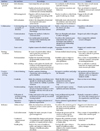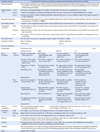Abstract
Purpose
This study was conducted to develop a nursing leadership program outcome evaluation system, required for accreditation of nursing education.
Methods
A methodological design was used. To ensure the theoretical validity of the evaluation system, learning objectives for nursing education programs and job descriptions for nurses in Korea were verified by analyzing the relationships in the five attributes of the nursing leadership concept. The nursing leadership program outcome evaluation system was developed based on the Kim & Park's developmental model (2008).
Figures and Tables
Table 1
Classification of Learning Objectives for Subjects in Nursing by Attributes of Nursing Leadership

References
1. Song JE, Park JW, Yoo MS. Nursing program learning and development of assessment system- centrally about improvement of applying skills of the nursing process based on critical thinking skills -the first time learning and research- based nursing curriculum presentation competition. Seoul: Korean Accreditation Board of Nursing Education;2013.
2. Park MJ. A new approach to curriculum development in higher education: Competence-based curriculum. J Curriculum Stud. 2008; 26(4):173–197.
3. Kim BK, Park JY. A study on assessment method of program outcomes. J Eng Educ Res. 2008; 11(4):46–57.
4. Baek SG. Principles of performance assessment. Seoul: Kyoyookbook;2000.
5. Kim JS, Kim YM, Jang KS, Kim BN, Jeong SH. Concept analysis of nursing leadership. J Korean Acad Nurs Adm. 2015; 21(5):575–586. DOI: 10.11111/jkana.2015.21.5.575.
6. Kim EK, Yoo MR, Park KH, Keum KL, Jung EY. Concept development of military nursing leadership. J Mil Nurs Res. 2015; 33(2):15–31.
7. Korean Nurses Association. Nursing education learning objectives. Seoul: Korean Nurses Association;2012.
8. Park IS. Research report of 2nd job description of nurses. Seoul: Korea Health Personnel Licensing Examination Institute;2012.
9. Finkelman AW.
SI Yu
. Leadership and management for nurses: Core competencies for quality care. 2nd ed. Seoul: Haneon;2013.
10. Krathwohl DR, Bloom BS, Masia BB. Taxonomy of educational objectives: The classification of educational goals. Handbook 2. Affective domain. New York: Longmans, Green;1956.
11. Bloom BS, Engelhart MD. Taxonomy of educational objectives: The classification of educational goals. Handbook 1. Cognitive domain. New York: Longmans, Green;1956.
12. Kim BN, Kim SO. A study on assessment system for nursing bachelor degree program outcomes: Focused on communication ability improvement. J Korean Acad Nurs Adm. 2014; 20(2):154–166. DOI: 10.11111/jkana.2014.20.2.154.
13. Jang KS, Jung KH, Pack M, Park HY, Choi O. Action learning and creative problem solving for nursing leadership. Seoul: Hyunmoonsa;2016. p. 27–42.
14. Choi HS. Curriculum and educational evaluation: Understanding and application. Paju: Kyoyookbook;2008.
15. Kim JG. Curriculum and educational evaluation. 2nd ed. Seoul: Dongmunsa;2007.
16. O'Mara L, Carpio B, Mallette C, Down W, Brown B. Developing a teaching portfolio in nursing education: A reflection. Nurse Educ. 2000; 25(3):125–130.
17. Rider EA, Brashers V. Team-based learning: A strategy for interprofessional collaboration. Med Educ. 2006; 40(5):486–487. DOI: 10.1111/j.1365-2929.2006.02434.x.
18. Zgheib NK, Dimassi Z, Bou Akl I, Badr KF, Sabra R. The longterm impact of team-based learning on medical students' team performance scores and on their peer evaluation scores. Med Teach. 2016; 38(10):1017–1024. DOI: 10.3109/0142159x.2016.1147537.
19. Chamblee TB, Dale JC, Drews B, Spahis J, Hardin T. Implementation of a professional portfolio: A tool to demonstrate professional development for advanced practice. J Pediatr Health Care. 2015; 29(1):113–117. DOI: 10.1016/j.pedhc.2014.06.003.
20. Naver Wikipedia. Performance evaluation [Internet]. cited 2016 October 28. Available from: http://terms.naver.com/entry.nhn?docId=2178379&cid=51072&categoryId=51072.
21. Schwirian PM. Evaluating the performance of nurses: A multidimensional approach. Nurs Res. 1978; 27(6):347–351.
22. Arter JA, McTighe J. Scoring rubrics in the classroom: Using performance criteria for assessing and improving student performance. Thousand Oaks, Calif.: Corwin Press;2001.
23. Kim JY, Kang SJ, Kang BS, Kim DI. A study on development of the assessment system for the program outcomes on the communication skill competence. J Eng Educ Res. 2011; 14(6):41–47.
24. Oermann MH, Gaberson KB.
JA Oh
YH Kang
SJ Shin
GH Kim
JA Kang
. Evaluation and testing in nursing education. Paju: Soomunsa;2015.
25. Park HT. Transformational and transaetional leadership styles of the nurse administrators and job satisfaction, organizational commitment in nursing service. J Nurs Acad Soc. 1997; 27(1):228–241.
26. Marquis BL, Huston CJ.
KS Jang
MY Kim
JA Kim
GO Park
BS Lee
SJ Kang
. Leadership roles and management functions in nursing: Theory and application. 7th ed. Seoul: Jungdam Media;2015.
27. Alexander MF, Runciman PJ. International Council of Nurses. ICN framework of competencies for the generalist nurse: Report of the development process and consultation. Geneva: International Council of Nurses;2003.
28. Park YS, Glenn JC. State of the future 2050. Seoul: Kyobobook;2016.
29. Human Resources Development Service of Korea. National competency standards [Internet]. Seoul: Human Resources Development Service of Korea;cited 2016 October 27. Available from: http://www.ncs.go.kr/ncs/page.do?sk=P1A4_PG09_005.
30. Korea Research Institute for Vocational Education & Training. Korea collegiate essential skills assessment [Internet]. Sejong: Korea Research Institute for Vocational Education & Training;cited 2016 October 29. Available from: http://www.kcesa.re.kr/index.do.




 PDF
PDF ePub
ePub Citation
Citation Print
Print






 XML Download
XML Download